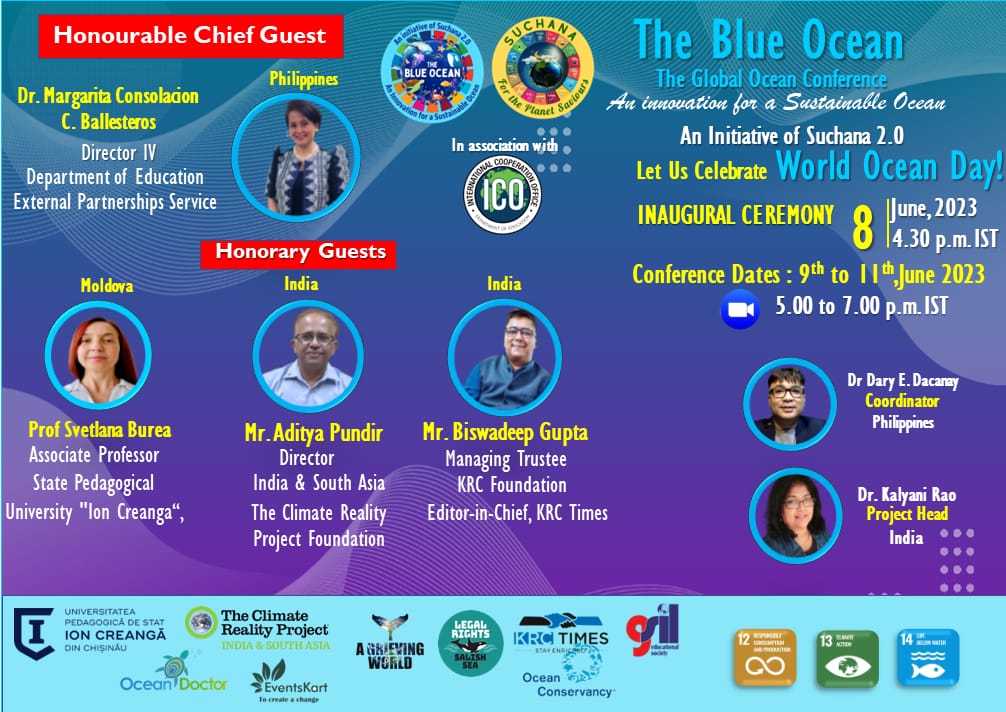Excerpts of talk by the Editor-in-chief of KRC TIMES at the Global UN SDGs Ocean Conference – The Blue Ocean, an innovation for a sustainable ocean
 Biswadeep Gupta
Biswadeep Gupta

Ladies and gentlemen, thank you for inviting me to engage in a conversation with you and my theme is How deforestation affects the blue oceans and our lives. Let me begin my expose with a small quote by Sarah Kay, the American poet: “There’s nothing more beautiful than the way the ocean refuses to stop kissing the shoreline, no matter how many times it’s sent away.”
The ocean is the largest ecosystem on Earth, and it is the planet’s life support system. As we all know the Earth is a watery place. About 71 percent of the Earth’s surface is water-covered, and the oceans hold about 96.5 percent of all Earth’s water.
This data shows how important and precious it is to conserve the oceans. Everything — from the tops of mountains to the bottom of the ocean — is interconnected. Salmon bring nutrients from the ocean upstream into rivers where they in turn provide food for eagles and bears and eventually enrich forest plants.
What we put into our water upstream affects the animals and plants downstream. These are all interconnected. For far too long, people assumed that the ocean was limitless and immune to human impacts. Only recently, scientists have come to understand the devastating impact and continued threat of human activities on the ecosystem of Ocean. Overfishing, rising temperature, pollution, habitat destruction, invasive species, oil spills and other forms of human exploitations have put our ocean at risk. No area has been left untouched.
Forests cover about 30 percent of the planet’s land mass, but humans are cutting them down, clearing these life supporting habitats on a massive scale. As the world seeks to slow the pace of climate change, preserve wildlife, and support more than eight billion people, trees inevitably hold a major part of the answer.
Yet the mass destruction of trees—deforestation—continues, sacrificing the long-term benefits of standing trees for short-term gain of fuel, and materials for manufacturing and construction business. ‘The ocean has long taken the brunt of the impact of human-made global warming’, says UN Climate Change.
Our global oceans absorb roughly a quarter of the CO2 released by human activities every year. As the planet’s greatest carbon sink, the ocean absorbs excess heat and energy released from rising greenhouse gas emissions trapped in the Earth’s system. Today, the ocean has absorbed about 90 percent of the heat generated by rising emissions.
As the excessive heat and energy warms the ocean, the change in temperature leads to unparalleled cascading effects, including melting of ice, rising sea-level, marine heatwaves, and ocean acidification. These changes ultimately cause a lasting impact on marine biodiversity, and the lives and livelihoods of coastal communities and beyond.
Life of 680 million people are living in low-lying coastal areas and almost 2 billion people live in costal megacities of the world are intertwined with ocean. Nearly half of the world’s population (3.3 billion) depends on fish for protein, and almost 60 million people work in fisheries and the aquaculture sector worldwide.
Impact of Deforestation
The most immediate impact of deforestation occurs at the local level with the loss of ecological services provided by tropical rainforests and related ecosystems. Such habitats provides valuable services such as erosion prevention, flood control, water filtration, fisheries protection, and pollination—functions that are particularly important to the world’s poorest people, who rely on natural resources for their everyday survival. Forest loss also reduces the availability of renewable resources like timber, medicinal plants, nuts and fruit etc.
Deforestation of tropical rainforests over the longer term can have a broader impact, affecting global climate and biodiversity. These changes are more challenging to observe and forecast since they take place over a longer time scale and can be difficult to measure.
Deforestation has the most immediate effect at the local level. With forest loss, the local community loses the system that performed valuable but often under-appreciated services like ensuring the regular flow of clean water and protecting the community from flood and drought.
The forest acts as a sort of sponge, soaking up rainfall brought by tropical storms while anchoring soils and releasing water at regular intervals. This regulating feature of tropical rainforests can help moderate destructive flood and drought cycles that can occur when forests are cleared.
When forest cover is lost, runoff rapidly flows into streams, elevating river levels and subjecting downstream villages, cities, and agricultural fields to flooding, especially during the rainy season. During the dry season, such areas downstream of deforestation can be prone to months-long droughts which interrupt river navigation, wreak havoc on crops, and disrupt industrial operations.
Additionally, the forest adds to local humidity through transpiration (the process by which plants release water through their leaves), and thus adds to local rainfall. For example, 50-80 percent of the moisture central and western Amazon remains in the water cycle of the ecosystem. In the water cycle, moisture is transpired and evaporated into the atmosphere, forming rain clouds before being precipitated as rain back onto the forest.
When the forests are cut down, less moisture is evapotranspired into the atmosphere resulting in the formation of fewer rain clouds. Subsequently there is a decline in rainfall, subjecting the area to drought. If rains stop falling, within a few years the area can become arid with the strong tropical sun baking down on the scrub-land.
Today Madagascar is largely a red, treeless desert from generations of forest clearing with fire. River flows decline and smaller amounts of quality water reach cities and agricultural lands.
There is serious concern that widespread deforestation could lead to a significant decline in rainfall and trigger a positive-feedback process of increasing desiccation for neighboring forest cover; reducing its moisture stocks and its vegetation would then further the desiccation effect for the earth.
Some of the major consequences of the impacts of climate change on the ocean are:
(i) Rising Sea-level
Rising Sea-level has accelerated in recent decades due to increasing ice loss in the world’s polar regions. Latest data from the World Meteorological Organization shows that global mean sea-level reached a new record high in 2021, rising an average of 4.5 millimeter per year over the period 2013 to 2021.
(ii) Marine heatwaves
Marine heatwaves have doubled in frequency, and have become longer-lasting, more intense and extensive. The IPCC says that human influence has been the main driver of the ocean heat increase observed since the 1970s.
(iii) Loss of marine biodiversity
Rising temperatures increase the risk of irreversible loss of marine and coastal ecosystems. Today, widespread changes have been observed, including damage to coral reefs and mangroves that support ocean life, and migration of species to higher latitudes and altitudes where the water could be cooler.
The sea is a tremendously important resource for man, and some of the world’s largest cities lie along the coast for trade and commercial fishing. Any rise in sea level would directly affect these metropolises, causing flooding and the potential disruption of sewage and transit systems, along with inundating neighboring agricultural plots.
A change in sea levels will also affect coastal ecosystems like river deltas, wetlands, swamps, and low-lying forests, which play an important role in providing services for mankind, in addition to housing biological diversity.
Though sea levels have been higher in the past, today there is less room for species affected by flooding, since buildings and concrete now occupy the areas that were once extensions of their environment. Modern humankind is so dependent on existing conditions, that a change in sea level, even if it is 10-20-inch (25-50 cm) will have a drastic effect on our society.
Global warming is as much a social problem as it is an environmental one. Now is the time to act. Each and every one of us can make a difference.
Let me conclude with a small quote:
“With every drop of water you drink, every breath you take, you’re connected to the sea.”
— Sylvia Earle


